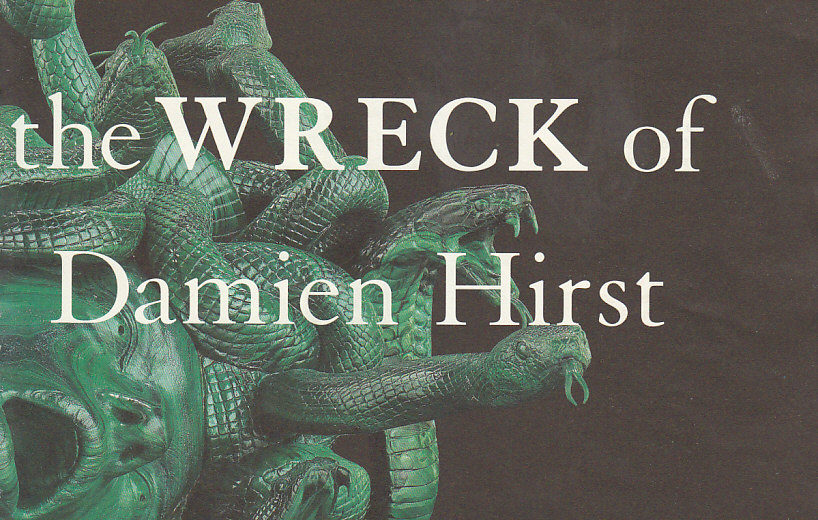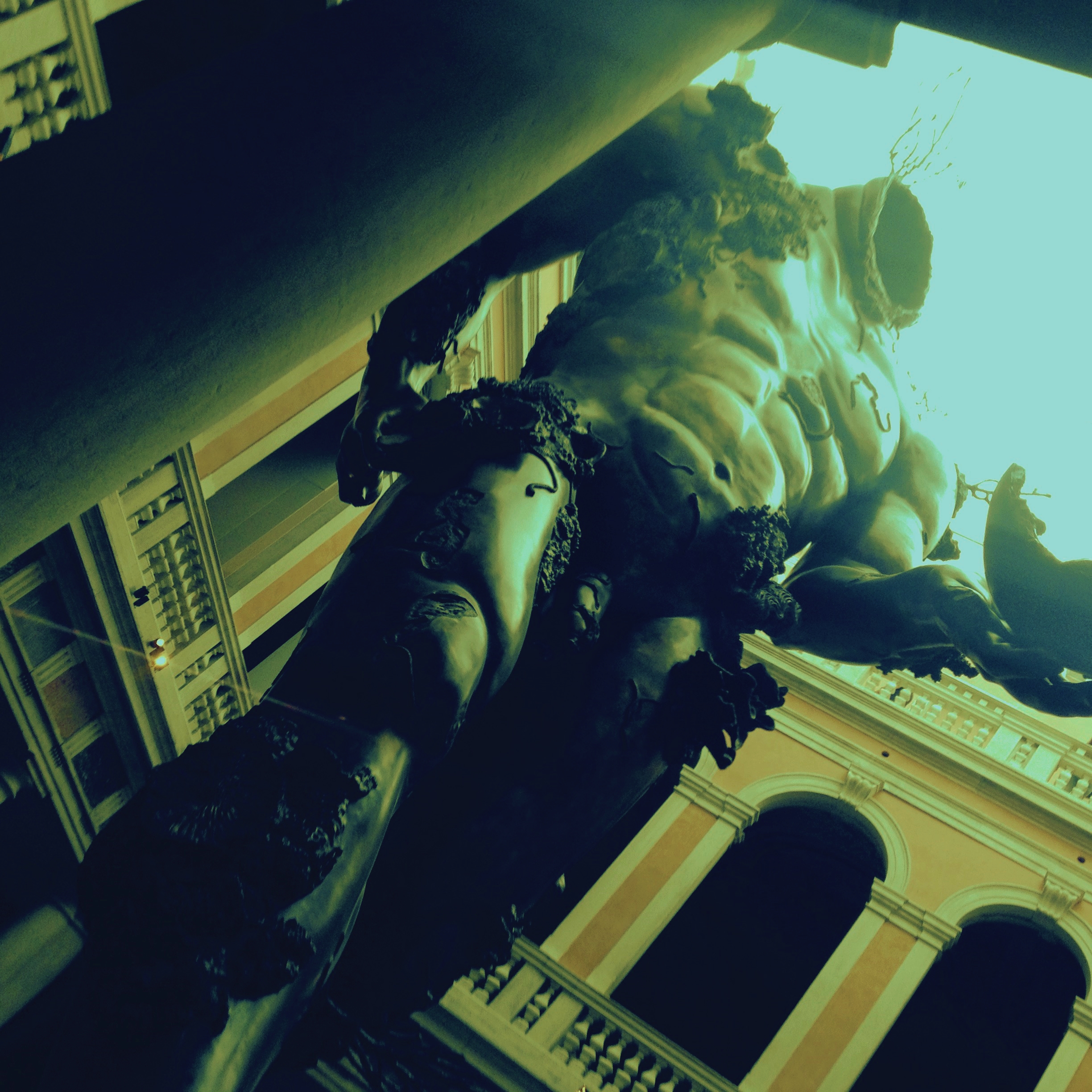WOID XXI-37
DEBT in VENICE
Damien Hirst. The Wreck of the Unbelievable. Venice: Dogana and Palazzo Grassi, May 9 through December 3, 2017.
The founding moment of the Museum as we know it came when the ambassadors of conquered nations went to Rome, and saw the images of their gods and patrons set up as meaningless trophies of power, and wept. Our present moment of despair has come with the gaudy junk dumped on Venice by Damien Hirst and his handlers—but, hey, any town that's survived Versace and faux Murano glass will survive this. In visual terms alone the whole experience is so stupid, so kiss-ass hokey your initial impulse is to reach for the remote: it begins with videos of underwater divers pulling supposedly sunken treasures from a wreck, the kind of thing you get on the Discovery Channel at 2:00 am; then you hike through enormous spaces where the presumed loot is displayed: garish takeoffs of traditional high art forms encrusted with bright-colored fake cockles and coral. If this were a sophomore project at a Midwestern college it could pass for an attempt at “Institutional Critique,” the kind of thing Andrea Fraser pulls off with a heavy hand and a light budget: the Venice show might have made sense if it had limited itself to the booklet that's available for free at the admissions desk, and that weakly parodies archeological jargon the way Fraser parodies art-historical jargon:
This bust—which has been cautiously identified as the fourteenth century BCE Mitannian princess, Tadukheba…
Irony? If you’re going to argue this show is ironic then you might as well argue Donald Trump is ironic when he covers the walls of the White House with gold. Hirst’s art until now had stopped short of the cynical operator, he used to make you think he wasn’t quite taken in by his own ploys and that gave his earlier works a certain grace, like a Venetian hustler who’s so good at it he leaves you feeling honored to have been conned. Not this time: the new works on display are not merely humongous, they add little to the historical styles they parody beyond the clumsy sadism of a second-hand Roman copy of a Hellenistic original. For sophisticated irony they’re on the level of an Indiana Jones movie without the lightness of touch, or the sweetness.

Remember that Hegelian guff from the ‘sixties? Art was not what people did at any given time and called “Art,” for want of a better word; Art was the incarnation of the progress of the Spirit of Art in History, and the Great Artist was he [sic] who, having absorbed and overcome the History of Art (thesis-antithesis-synthesis), took his rightful place in the Vanguard as the Man of Destiny, the true spirit of the Zeitgeist, transcending by transforming. That was the 'sixties; Damien hasn’t got the message. His frame of reference is a fifty-year old slide show from Art 101. For an epigram the booklet quotes the song from Shakespeare's Tempest:
Of his bones are coral made;
Those are pearls that were his eyes.
Except that Shakespeare questions the ability of human practice to make of nature “Another Nature” beyond Nature itself, within the context of dawning European colonialism and imperialism. With Hirst this fragment suggests the opposite: the art of the present is in a position to colonize and improve all cultures of the past; vicious, overwhelming and prodigiously expensive art is the wave of the future, get used to it; but as Marx once put it in a well-known critique of Schiller, art and images from the past can never empower us to recreate the historical conditions that brought the past into being, they can only empower us through the discrepancy between the past they claim to represent and the present with which they clash. Whatever irony arises, quite inadvertently, from Hirst’s work is due to this discrepancy: between what it claims to represent (the History of all Art, past and present) and its promise for the future:
A shattered visage […] whose frown,
And wrinkled lip, and sneer of cold command…
Sure sounds like Donald Trump, doesn’t it?
Marx, in another well-known passage, argues that the true profile of the artist under Capitalism is not the lonely struggler in his studio, it's the mastermind whose genius lies, not in making or even conceiving art, but in rationalizing the production and reproduction of art on the greatest, most efficient scale; which is to say that the Great Artist category fits Hirst to a T so long as you're willing to believe The Wreck of the Unbelievable a) summarizes in one place the whole of the preceding history of art and b) that the history of all hitherto produced art is the history of Savage Capitalism. The show is held in part at the Dogana, the large and beautifully sited space that faces San Marco, and in part at Palazzo Grassi, on the Grand Canal; both are owned by the deal-maker François Pinault, someone for whom controlling Christie's or Louis Vuitton, or controlling the production and reception of art are all one and the same because, well, aren’t they? “Look on my Works, ye Mighty, and despair:” this is Ozymandias without the concluding line.
The show is held in conjunction—or more accurately, in competition—with the Venice Biennale. Here I must explain that the Venice Biennale consists of expanding and interlocking circles of cultural production. At the center of it all is the Biennale proper, the once-every-other-year display of art from various countries under the direction of a designated curator, which is held in the Central Pavilion of the Giardini and in the Arsenale nearby. Beyond that there are the national pavilions in the Giardini, though many countries set up their own pavilions throughout Venice; then there are the private exhibitions in permanent or temporary spaces, which may be sponsored by galleries, or individual artists, or for-profit corporations, and beyond that a considerable number of guerrilla actions by independent artists or collectives:
And then there is the Hirst production that hopes to suck the air out of everything else on the plane of aesthetics as well as economics, the two being one and the same in the mind of Hirst and Pinault and the mainstream critics. As Holland Cotter of the New York Times explained, the Venice Biennale “feels almost perversely out of sync with the political moment,” an accusation not to be made of the Hirst show, clearly. Likewise in the same rag Jason Farago describes how “oversize crowds of collectors and the regulars of Europe's partying class swarmed the lagoon." He must have confused the Venice Biennale with Art Basel.
Of course this is what the Times does, and has been doing for a long, long time: supporting and promoting a situation in which nothing in the realm of Art is allowed to survive, nothing is allowed to exist that isn't "covered" by the Times, meaning: that isn't heavily capitalized. Art, for the Times, has always been about the money behind it. Hirst is the genius who brings the money front and center.
I'd be happy to believe the largest sculpture in the Hirst show—a striding acephalous athlete over fifty feet high—is a reference to the imminent collapse of the Trumpocracy, the way the acephalous warrior statue in the fourth canvas in Cole’s Course of Empire (1836) was meant to warn of the eventual collapse of a decadent American Empire:

But the absence of any internal corroboration from Hirst makes that interpretation ludicrous: This show's not Ozymandias, it's Ozymandias Triumphant; and though it would be comforting to twist the whole mess as an unconscious prophecy of the ultimate collapse of Savage Capital I have another, more modest if equally prophetic thought:
In 1202 a mighty crusader army descended on Venice, bound for the Holy Land. The Venetians were impressed: in the meantime, perhaps the gentili crusaders would be more comfortable off on the Lido while their boats were made ready? After a few weeks the crusaders were presented with the bill—for the boats, the service and the pane e coperto; more than the knights could pay, but if they could see their way, instead of conquering the Holy Land, to conquer the neighboring city of Zara, which had rebelled against the Venetians, eh? I enjoyed the Biennale for the same reasons I’ve enjoyed it in years previous: it’s relaxed, it’s uncrowded, the blow-hards are thin on the ground, the visitors are interested in looking at art, not buying it; and as much as possible it’s not about the money. And “not about the money” will last a lot longer than the money; even yours, François.
June 5, 2017; last revised June 10.

